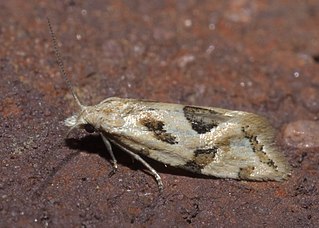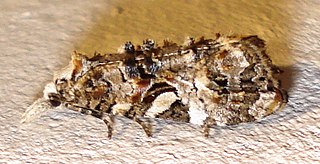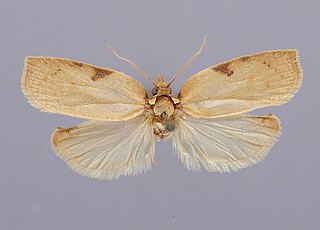
The Cochylini are a tribe of tortrix moths. It used to be classified as the subfamily Cochylinae.

Crocidosema plebejana, the cotton tipworm, is a tortrix moth, belonging to tribe Eucosmini of subfamily Olethreutinae. It is found today all over the subtropical and tropical regions of the world and even occurs on many oceanic islands – in Polynesia and Saint Helena for example – but has probably been accidentally introduced to much of its current range by humans. In addition, it is also found in some cooler regions, e.g. in Europe except in the east and north; this is probably also not natural, as it was, for example, not recorded in the British Isles before 1900.

Crocidosema is a genus of tortrix moths belonging to the tribe Eucosmini of subfamily Olethreutinae. They are found mostly in the Southern Hemisphere, being especially common in the Neotropics. But some occur elsewhere, such as on the Hawaiian Islands.

Lorita is a genus of moths belonging to the subfamily Tortricinae of the family Tortricidae.

Acleris is a genus of moths belonging to the subfamily Tortricinae of the family Tortricidae. As of 2007, about 241 species were known.

Aethes is a genus of moths belonging to the subfamily Tortricinae of the family Tortricidae.
Chrysoxena is a genus of moths belonging to the subfamily Tortricinae of the family Tortricidae.
Templemania is a genus of moths belonging to the subfamily Tortricinae of the family Tortricidae.
Tinacrucis is a genus of moths belonging to the subfamily Tortricinae of the family Tortricidae.

Epinotia signatana is a moth of the family Tortricidae. It is found from England and Scandinavia to the Mediterranean Sea, to eastern Russia, China, Korea, Burma and Japan.

Eugnosta is a genus of moths belonging to the family Tortricidae.

Phtheochroa is a large genus of tortrix moths. It belongs to the tribe Cochylini of subfamily Tortricinae.

Lantanophaga pusillidactyla, the lantana plume moth, is a moth of the family Pterophoridae. It is native to the southern United States, Mexico, the Caribbean, and South America. It was introduced to Australia accidentally in 1936 and is now found from Sydney to Cairns along the coast. It has also been introduced to Hawaii in 1902, Pohnpei in 1948, and Palau in 1960 for biological control. It has since been recorded from Yap in 1987–1988 and is now distributed on all islands of the Mariana and Caroline Islands where the host plant is found, except Aguijan.

Amorbia emigratella, the Mexican leaf-roller, is a moth of the family Tortricidae. Although it was described from Hawaii, it is known to be a native of the southern United States, Mexico and Central America. It was first described by August Busck in 1910.
Crocidosema insulana is a species of moth of the family Tortricidae. It is found in Chile in Santiago, Masatierra Island, Coquimbo, Valparaiso, Maule and Bío Bío.
Crocidosema leprarum is a moth of the family Tortricidae. It was first described by Lord Walsingham in 1907. It is endemic to the Hawaiian islands of Oahu, Molokai, Nihoa, Necker, French Frigate Shoals and Laysan.
Crocidosema marcidellum is a moth of the family Tortricidae. It was first described by Lord Walsingham in 1907. It is endemic to the Hawaiian islands of Kauai and Oahu.
Cremastobombycia lantanella, the lantana leaf miner, is a moth of the family Gracillariidae. It was first described by August Busck in 1910. It is native to the southern United States and Mexico. It was introduced to Hawaii in 1902 to aid in the control of Lantana plants.











